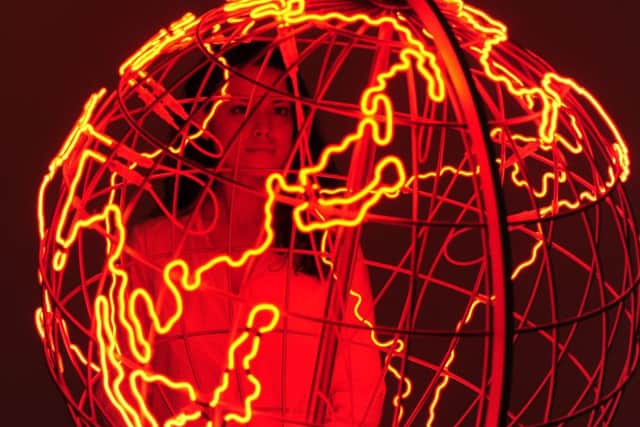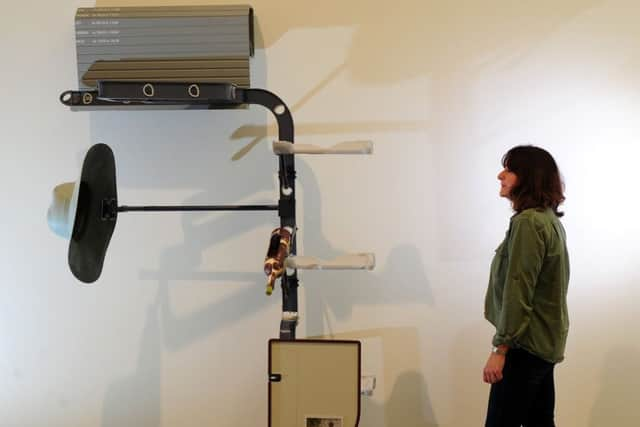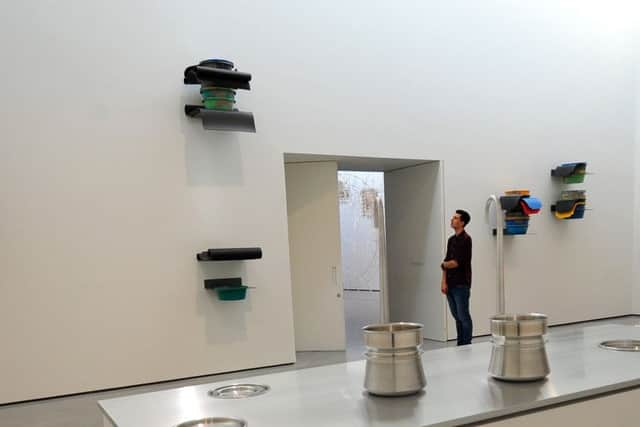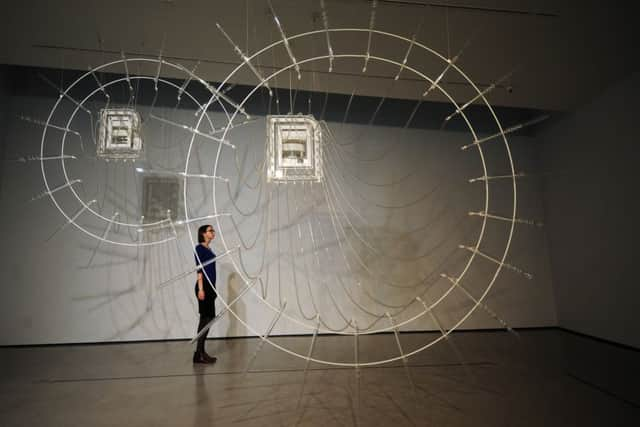The art of the possible - The Hepworth Prize for Sculpture
In the seven years since it opened in 2011, the Hepworth Wakefield has been at the cutting edge of innovative thinking in the visual arts. Right from the start, they have aimed high with ambitious, ground-breaking, world-class exhibitions – and they have consistently hit the mark.
It was no surprise, then, that in 2016 the gallery launched the Hepworth Prize for Sculpture, the UK’s first ever sculpture prize. The £30,000 biennial award recognises a British or UK-based artist of any age, at any stage in their career who has made a significant contribution to the development of contemporary sculpture. The inaugural prize was won by Helen Marten, who went on to also win the Turner Prize that year, and this year five shortlisted artists are in contention. Their work is now on display in an exhibition which opened last week and the winner of the 2018 prize will be announced later this month.
Advertisement
Hide AdAdvertisement
Hide Ad“One of the things I have been most excited about is seeing five artists approaching sculpture so differently,” says curator Lauren Barnes as we walk through the exhibition a few days before the opening. “It has been fascinating to see how each of them has thought about the space here and the various processes they have gone through to bring an object into the world. Hopefully that will come across in the show.”


It is indeed, a rich and varied exhibition, with each artist’s room presenting thought-provoking encounters that push at the boundaries of what sculpture is and can be. What is also very exciting is that all five artists – Michael Dean, Mona Hatoum, Phillip Lai, Magali Reus and Cerith Wyn Evans – are showing new work.
One of these is Cerith Wyn Evans’ Composition for 37 flutes (in two parts), the largest single sculpture in the exhibition. Made up of 37 crystal glass flutes configured into two intersecting arcs, it is suspended in the gallery space. Wyn Evans often incorporates sound into his work and here mechanical lungs power the individually pitched flutes, giving out an ethereal (slightly dissonant) musical soundtrack. The piece is both incredibly delicate – helped by its transparency – yet robustly ‘alive’; it breathes as you walk around it. Wyn Evans is often mindful of how his work resonates within the existing architecture – and it certainly feels as though it belongs there, working so well with the gallery’s natural light.
In a nearby room Michael Dean is putting the finishing touches to his large-scale installation Of or for LOL which fills the space in a totally engaging and absorbing way. His work always begins with writing, he explains. “I start with pen on paper, accumulating words and they become the material that I then try to translate or transmute into something else.” He shapes the text into physical form and for the piece at the Hepworth draws on recent shows, putting elements together in a different way. Winding across the room is a kind of path that visitors are encouraged to walk on. Along the way are small fragments of detritus, crime scene tape, coins, padlocks and building materials – Dean describes these as “things that people leave behind”. It is a powerful work with a thoughtful and careful attention to detail.
Advertisement
Hide AdAdvertisement
Hide AdMagali Reus’ work makes something extraordinary out of the ordinary. “She finds everyday objects or images as a starting point for her work,” explains Barnes. “She then transforms them, making each component herself. It is so precisely fabricated. It is a joy to look at all the detail.” Reus has brought new works from her Sentinel series which combine references to woven fire hoses and nozzles, with other elements cast in fibreglass and metal. There are also four works from a new series entitled Dearest which incorporates ladders, hats and bottles to tell a romantic tale. “For this she is thinking about sculpture as a potential love song,” says Barnes. “She takes a functional object like a ladder and then applies many other layers of association or meaning.” It is work that requires close attention – and there are plenty of little subtle touches to discover, such as a tiny photograph tucked away behind one of the ladder steps.


Phillip Lai also uses everyday objects in his work, taking mass-produced items like plastic bowls and garden centre-type pots, aligning them with his own precisely fabricated forms; we are then invited to ‘spot the difference’ but also to think about their function and what they might represent in our material world. “There is a degree of things being not quite what they seem,” says Barnes. “He describes his work as a questioning process that asks more questions than it answers.”
The centrepiece of Mona Hatoum’s contribution is new work Hot Spot, a pulsating neon red globe on a stand that depicts a world literally throbbing with conflict. Her collection of works range in scale from the very small – intricate little ‘drawings’ made from strands of her hair on handmade paper – to the huge, in terms of ideas and ambition. It confronts notions of creation and destruction and humanity’s role in that. Natura morta (medical cabinet) is a perfect example of that – it is a glass wall-mounted cupboard containing grenades made out of beautiful Murano mirrored glass; if ever an artwork spoke of the contrasting actions of which human beings are capable, this is it. “Her work really goes from the cellular to the universal,” says Barnes.
The same could be said of the exhibition itself – its themes range from the personal and intimate to the political and global; it is a brilliant showcase for a group of extremely talented artists. All are worthy of the prize, it will be interesting to hear who the judges choose.
Advertisement
Hide AdAdvertisement
Hide AdAt the Hepworth Wakefield until January 20, 2019. The winner of the Hepworth Prize for Sculpture 2018 is announced on November 15.


The five shortlisted artists for The Hepworth Prize for Sculpture 2018
Michael Dean: Dean was born in Newcastle in 1977 and now lives and works in London. He was nominated for the Turner Prize and has enjoyed solo exhibitions both in the UK and abroad, including in London, Rome, Amsterdam and the Henry Moore Institute, in Leeds in 2012. He says of his work: “I want to try and generate an autonomy for the viewer, centering them in front of the work, instead of the work in front of them.”
Mona Hatoum: Hatoum was born in Beirut in 1952 and now resides in London. Since the 1990s she has focused more on sculpture and installations and in recent years has enjoyed major exhibitions at the Centre Georges Pompidou in Paris and London’s Tate Modern. She says: “Every aspect of life is full of contradictions: some people think that aesthetics and politics don’t mix, but that’s ridiculous.”
Advertisement
Hide AdAdvertisement
Hide AdPhillip Lai: Lai was born in Malaysia and now lives and works in the UK. He has enjoyed several solo exhibitions in the capital and has been a lecturer in Fine Art at Goldsmiths, University of London, since 2001. He is interested in the idea of his work having “an alien relation to an audience”, in spite of its familiar forms.


Magali Reus: The Dutch-born artist lives and works in London. She had her first UK museum solo exhibition at The Hepworth Wakefield in 2015 and has since enjoyed shows in London and Amsterdam. “I’m interested,” she says, “how a simple form can generate an immediate chain of associations – people, places, smells and sounds.”
Cerith Wyn Evans: Wyn Evans comes from Wales and first came to attention as an experimental film-maker in the 1980s and later evolved to incorporate sculpture into his work. Last year, his white neon sculpture, Forms in Space... by Light (in Time) filled Tate Britain’s Duveen Galleries.